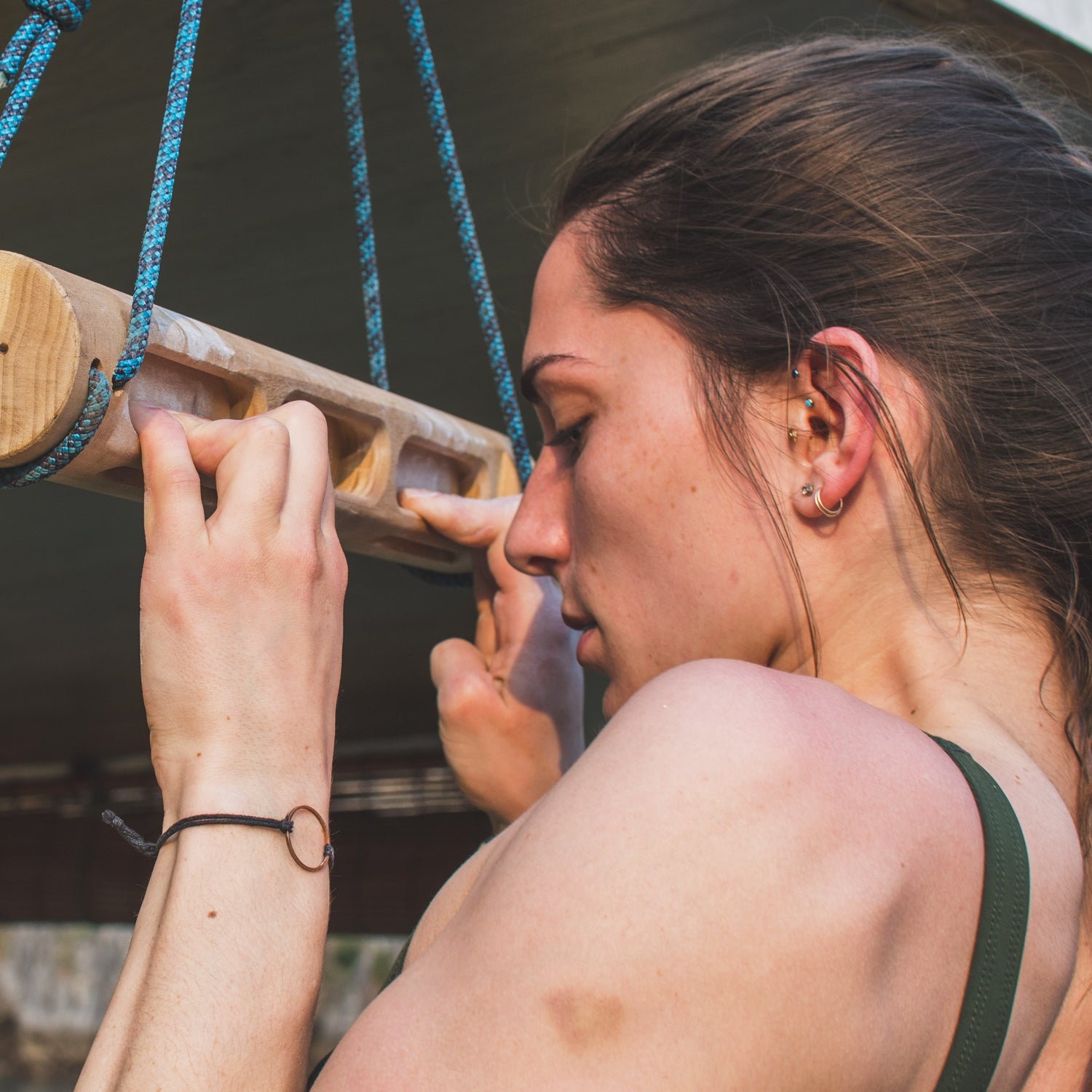Climbing loves consistency. But since the coronavirus pandemic has shut down gyms across the country, and ╠řis now discouraged, how do you stay strong while youÔÇÖre stuck at home?
ÔÇťPriority number one is maintaining your finger and large-pull-muscle strength,ÔÇŁ says ,╠ř▓╣╠řclimber, exercise scientist, and strength and conditioning specialist in Utah.╠řThe key is finding safe ways to continue to load your fingers at home without ratcheting up your pre-pandemic volume or intensity. ÔÇťIf we spend all of our time in quarantine doing new types of random workouts, thatÔÇÖs a recipe for injury, and it wonÔÇÖt necessarily translate back to climbing,ÔÇŁ he says.
According to╠řNelson, the best tool to help╠řmimic previous climbing habits is the hang board. Professional climbers like and ╠řare making good use of their hang boards while social distancing, but you donÔÇÖt have to be an experienced climber to take advantage of this device. ThatÔÇÖs because it lends itself to customization: you can easily╠řcontrol your workout difficulty by using different-size grips and adding or removing resistance. And at a time when experts are calling on outdoor enthusiasts to minimize their risk to avoid injuries, the hang board is a practical way to get a workout in.╠řÔÇťHang-boarding, by and large for the fingers, is much safer than climbing, because we have more control over individual variables like velocity and force vectors,ÔÇŁ says Nelson. In other words, youÔÇÖre not╠řgoing to make big, dynamic moves like you╠řdo while bouldering, or run the risk of a foot popping and sending a shock load into your╠řtendons and pulleys.
Follow this at-home, all-levels training routine recommended by╠řNelson╠řto help maintain your climbing strength and keep you prepared for a╠řreturn to the╠řgym or crag. Experienced climbers can use a board to train maximal finger strength, while exercises such as are good╠řfor beginners, says Nelson. ÔÇťEven if a beginner is grabbing on to a board and pulling hard, theyÔÇÖre not putting that much stress through their fingers, because their fingers arenÔÇÖt that strong,ÔÇŁ he says.╠řIf you donÔÇÖt have a hang board at home, you can use the top edge of a door frame (first check╠řto see if itÔÇÖs strong enough) or╠řthe upper-floor landing in a stairwell, or get creative and make╠řyour own. Any finger-friendly edge will do, but itÔÇÖs good to have a variety of size options.
The Moves
Hang Board Climbing Simulation╠ř
What it does: Mimics the finger stresses of climbing and╠řserves as a good warm-up for strength-specific finger exercises.
How to do it: Place a sturdy chair or stool on the ground just behind the hang board (the farther away it is, the more difficult this will be, since it simulates steeper climbing). Grab the jugs or large holds, place your feet up on the chair, then ÔÇťclimbÔÇŁ on the hang board as you would on a climbing wall:╠řlet go with one hand, reach toward the ceiling or out to the side, and return to a different grip. Try to mimic the movement of climbing as best as possible. Repeat with the other hand, aiming for 60 to 80 percent effort. Use different types of holds and edge depths for variety and to change the intensity.
Volume: Complete sets of 10 to 15 moves, with two to three minutes of rest between each set. Continue on and off for 45 to 60 minutes╠řtotal. ÔÇťItÔÇÖs not as fun as climbing, but if youÔÇÖre stuck at home and bored, this is a really effective use of time,ÔÇŁ says╠řNelson.╠řÔÇťWith╠řshort sessions, more experienced climbers can also train their fingers again later in the day.ÔÇŁ
Lock-Off Repeaters
What they do: Strengthen╠řthe bodyÔÇÖs big pulling musclesÔÇöthe lats, biceps, shoulders, and upper backÔÇöthrough isometric holds.
How to do them: Grab a pull-up bar or the jugs on a hang board, with your palms facing away. Engage your shoulders and core, then pull up until your elbows are bent 90 degrees. Hold for five seconds, then lower until your arms are straight, keeping your shoulders engaged to protect the joints. Complete another set with your arms bent to 120 degrees. If this is too challenging, use a resistance band for assistance: girth-hitch one end around the pull-up bar, and place your knee in the bottom of the loop to take the weight off your arms. If itÔÇÖs too easy, wear a weighted vest or your harness with weights hung from it.
Volume: Two sets (one at 90 degrees, one at 120 degrees) of five reps (five╠řseconds on, three╠řseconds off), with╠řone to three╠řminutes of rest between sets.
One-Arm Recruitment Pulls
What they do: Train╠řmaximum finger strength by forcing motor units to fire in unison.
How to do them: Find an edge size on the hang board that will work for your finger strength. Beginners should╠řaim for around 20 millimeters; experts, 15 to 10 millimeters. Stand underneath the hang board, reach overhead with one arm to grab the edge using either an or a grip, then pull down with 100 percent effort for three╠řto five╠řseconds. ItÔÇÖs OK╠řif your feet stay on the ground, says Nelson, as long as youÔÇÖre pulling with maximal effort. Keep your elbow bent at a large angle (120 to 150 degrees)╠řand not completely extended during the pull. Repeat with the other arm.
If thatÔÇÖs too easy, do a one-arm hang with your feet off the ground: find an edge depth that allows you to hang for around five seconds before hitting failure. Wear your harness and hang additional weight off it if necessary.
Volume: Three (beginners) to╠řfive╠ř(experts) repetitions for each grip (open hand and half crimp) on╠řeach hand. Rest for one to two╠řminutes. For expert climbers, complete a second set.
Density Hangs
What they do: Strengthen╠řthe flexor tendons and muscles of the fingers╠řto help make them more resilient against injury and allow you to climb and train at a higher intensity.
How to do them: Find an edge size on the hang board that you can hang from with both hands for approximately 20 to 40 seconds, then do so, keeping your╠řshoulders engaged, until failure. Beginners should╠řuse two grip positions: and . Experts should╠řuse three positions: open hand, half crimp, and .╠ř(Based on your strengths and weaknesses, you might need to use different edges for each hand position.)
Once you can hang for 30 seconds easily, progress by switching to a smaller edge. For advanced climbers without a smaller option, don and add weight to a harness.
Volume: One (beginners) to two╠ř(experts) sets of two to three╠řrepetitions per grip. Rest for three to five╠řminutes between hangs.
Front-Lever Progression
What it does: Trains climbing-specific core strength, targeting╠řdeep-core muscles,╠ř▓╣bs, your╠řback,╠řobliques, and hip flexors.
How to do it: Grab a pull-up bar or the jugs on a hang board, with your palms facing away. Engage your shoulders and core, then pull up until your elbows are bent to 90 degrees. Keep your body completely straight╠řfrom heel to head, then lean back as you raise your legs to enter a partial front lever. Go as far as you can while maintaining a rigid plank form, whether thatÔÇÖs only a few degrees back or a full front lever with your body parallel to the floor. Focus on breathing in this position. Hold for five seconds, then lower and rest for three seconds.
Volume: One to two╠řsets of╠řfive╠řseconds on, three╠řseconds off, for five to seven repetitions.
The Workout
Allow time for at least a 15-to-20-minute╠řwarm-up before diving into the workout. Try to match the volume and intensity of your climbing-gym routine as much as possible,╠řstarting╠řwith easy boulder problems or routes, resting between each, and gradually increasing╠řthe difficulty until youÔÇÖre ready to roll. Jog or jump-rope to raise your╠řheart rate, then do a set or two of pull-ups and burpees to get your╠řbig muscle groups fired up. Then do short, easy hangs (five╠řseconds on,╠řten╠řseconds off) to warm up your╠řfingers.
Once youÔÇÖve warmed up, transition to the workout. If youÔÇÖre a sport climber, aim for shorter rests between sets┬şÔÇöaround 15 seconds to a minuteÔÇöto emphasize endurance and capacity training. If youÔÇÖre a boulderer, use longer restsÔÇötwo to four minutes, or as long as you need to reach full recoveryÔÇöto focus on maximal strength and power. If you normally have a mobility or stretching routine, feel free to╠řadd that to the mix as well.
Beginner climbers should aim to do╠řfour training sessions per week.╠řSplit the recruitment pulls and density hangs between different days, separated by at least two days. Experienced climbers can realistically knock out╠řeight training sessions per week, splitting climbing and finger sessions between mornings and evenings.


